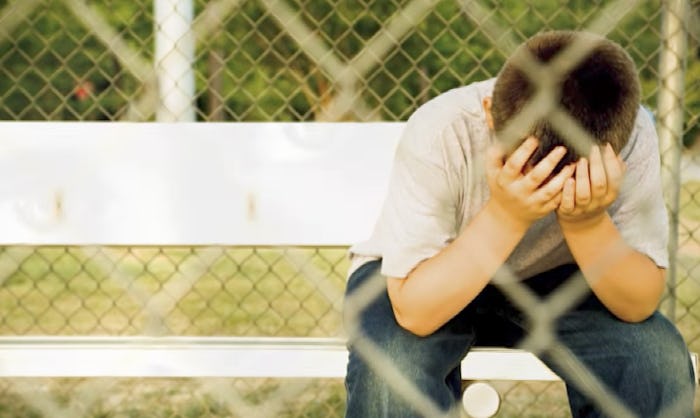News
A Shocking Number Of Kids In Foster Care Have PTSD
Tuesday, June 27 is National PTSD Awareness Day, which is meant to raise public awareness of Post Traumatic Stress Disorder (PTSD) and to start a conversation about what it is, who it impacts and how, and how it can be effectively treated. And though most people probably think of veterans and soldiers when they think of PTSD, the disorder actually affects a number of children as well. PTSD affects kids more often than you may think, because when you look at the number of kids with PTSD in foster care, they are, frankly, pretty upsetting.
According to The Denver Channel, National PTSD Awareness Day started in 2010, so it's been going strong for a couple of years now. The National Center for PTSD reported that about seven or eight out of every 100 people (so, around 7-8 percent of the population) will have PTSD at some point during their lives, and about 8 million adults have PTSD in the span of a given year. The National Center for PTSD is actually housed on the U.S. Department of Veterans Affairs website, and for the most part, people think of members of the military when they think of PTSD.
But what about kids?
According to Foster Focus Magazine, one out of every four (yes, about 25 percent) alumni of foster care experience PTSD, "and more than half experience at least one mental health issue such as depression, social phobia or panic syndrome." And the numbers reported by the National Center for PTSD are just as alarming.
The center reported that child protection services in the United States — which handle foster care — get around three million reports every year that involve 5.5 million children. Of those reported cases, there is proof of abuse in about 30 percent of them. Studies show that of children who go through trauma, according to the Center, 3 percent to 15 percent of girls and 1 percent to 6 percent of boys develop PTSD.
The National Center for PTSD reported that there are three factors that have been shown to raise the chance that a child will get PTSD: how severe the trauma is, how the parents involved react to the trauma, and how close or far away the child is from the trauma. Children or teens who go through the most severe trauma usually have the highest levels of PTSD symptoms, according to the Center.
According to a study by Harvard Medical School (HMS), the University of Michigan, and Casey Family Programs that the Harvard Crimson reported on, "foster children’s greater likelihood of mental health risks is primarily based upon the experiences, such as neglect and abuse, that children face before entering the foster system." But unfortunately, trauma is not totally uncommon for many in the foster care system, too.
And it's not just children in foster care who are affected. Essence magazine and Think Progress both recently did pieces on how PTSD impacts one particular adolescent group: children of color.
Essence reported on a recent study that showed that many residents who had been exposed to violence in cities like Detroit and Baltimore later noticed symptoms of PTSD like nightmares and obsessive thoughts. Chillingly, the publication went on to report that, in a series of federally funded studies in Atlanta in which more than 8,000 inner city residents were interviewed — most of them African-American — around 30 percent of respondents had had symptoms consistent with PTSD. That rate is as high or higher than the rate in veterans of wars in Vietnam, Iraq, and Afghanistan.
Essence made the point that kids are among those who face that violence. Think Progress also found that more than 60 percent of children have been exposed to violence in the last year.
According to an organization called Children's Rights, on any given day, there are almost 428,000 children in foster care in the United States. And in 2015, more than half of children entering foster care in the U.S. were young people of color. So the numbers reported by Essence, Think Progress, and Foster Focus can overlap.
Those numbers might seem really daunting. That's thousands of kids who might be affected by PTSD because of trauma they experience in foster care, or violence they witness, or both.
Luckily, groups like Kids Health offer ways to help. The first thing kids who are dealing with PTSD need, according to that resource, is support. But other care, like seeking professional help, is heavily emphasized as well. The National Center for PTSD recommended treatments like play therapy as well.
On this National PTSD Awareness Day, veterans and members of the military are a big part of the conversation about PTSD, as they should be. But let's not forget about the kids.
To learn more about Post-Traumatic Stress Disorder in children, visit the Child Mind Institute's website, or any of the previous links, including the National Center for PTSD's very informative site.
